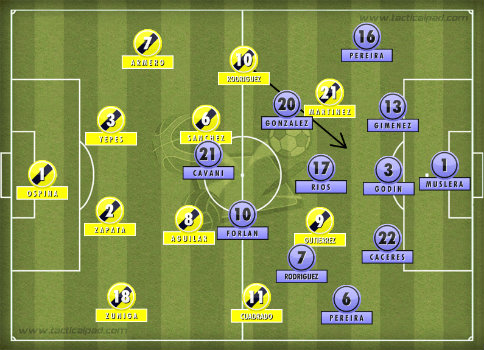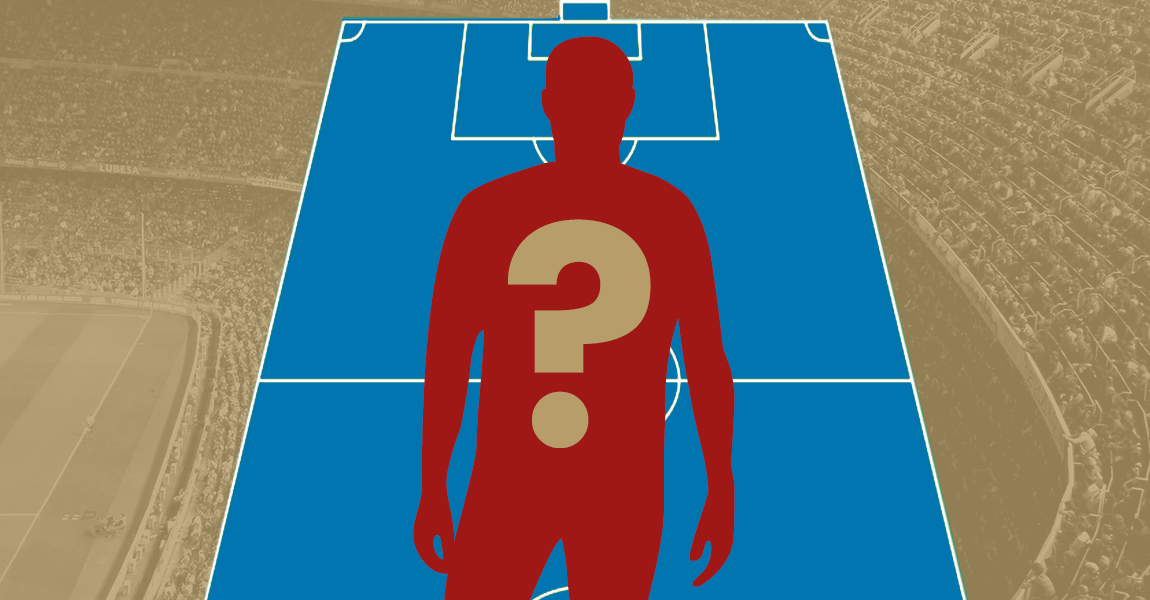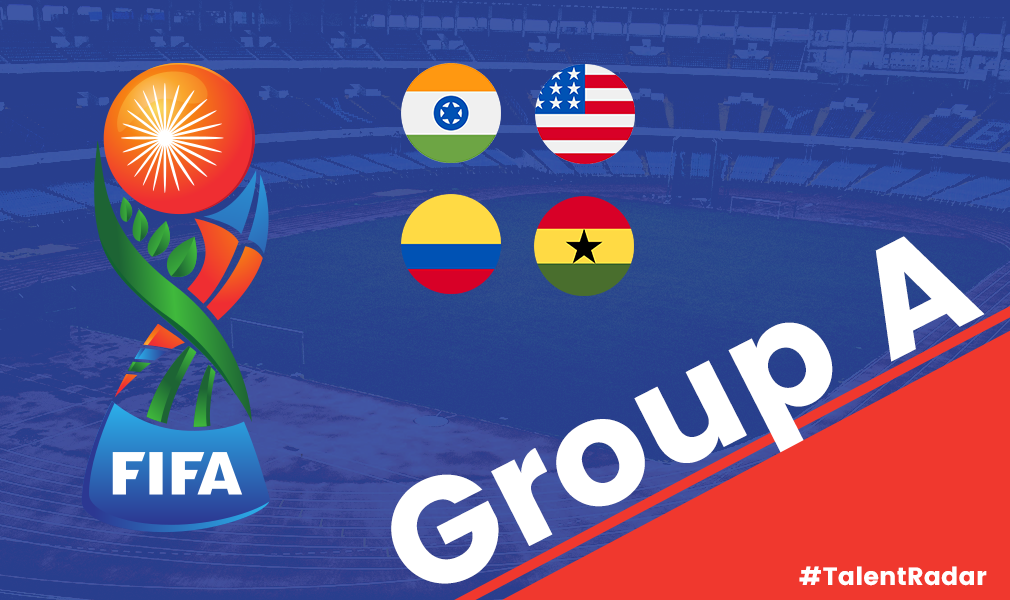In the second all-South American Round of 16 clash at the World Cup, the ever impressive Colombia took on Uruguay for a chance to face hosts Brazil. Colombia came into the game on the back of three comfortable wins in the group stage; Uruguay on the other hand, despite defeating both England & Italy, were yet to convince anyone of their proposed superiority and this was further thrown into doubt with Luis Suarez and his ‘behaviour’ once again.
Formation & Line-Ups
Colombia (4-4-2): Ospina, Zapata, Yepes, Zuniga, Armero, Sanchez, Aguilar, Cuadrado, Rodriguez, Martinez, Guiterrez
Uruguay (5-3-2): Muslera, Godin, Gimenez, Caceres, Pereira, Pereira, Rios, Gonzalez, Rodriguez, Forlan, Cavani
Goals: Rodriguez 28′ 50′

ANALYSIS
Uruguay’s questionable game-plan
Without deceiving readers here, their game plan was questionable purely because it was being implemented in the Round of 16 of the biggest tournament in the World, though it didn’t surprise many. Uruguay came into the game with the idea of sitting back and inviting pressure from the Colombians. Usually when this is done, you’d expect the side to soak in some attacking opposition before countering quickly to catch them out. The former bit was done, but the latter just never came.
Uruguay sat back, had men behind the ball, and allowed Colombia possession. It was a smart enough tactic from Oscar Tabarez, because Colombia is a side that would rather take advantage of spaces with gaps to run into. To cut off this space and force them to fashion chances out of their creativity while in possession is something that doesn’t exactly suit Jose Pekerman’s side; they instead love relying on their pace. This worked well for a period of time.
RELATED ARTICLES
But as the game wore on, despite the effectiveness of sitting back & deep, one had to question exactly what Tabarez was looking for. Did he plan to contain Colombia till 70 odd minutes before launching an attack? Did he intend to wear Colombia down? Was he looking at penalties? It was all a bit strange because a defensive set-up is well and good, but a knock-out round requires goals.
Whatever Tabarez’ game-plan was, it was certainly thrown out the window when they went a goal down before the first half-an hour and then conceded another. If his game plan was indeed to contain the Colombia attack without creating much on their own then you certainly have to blame his naive system for not having an alternative if Colombia were to take the lead, because it certainly looked like he only intended his side to attack in the latter stages, at least that’s how it played out. While Uruguay are a side looking to defend, Colombia too are capable of this albeit less effectively. The 2011 Copa America winners did finish the game with more shots, but this was only due to their opponents dropping off and allowing Uruguay attacks to take their place. 12 of their 16 shots came only after Colombia had already gone two-up.
Pekerman anticipates Uruguay’s plan for James
Against England in the group game, Uruguay followed a simple strategy to mark the player playing in the number 10 role – Wayne Rooney. They stuck defensive midfielder Arevalo Rios on him, who stuck to his man throughout the game and kept him under control. His duty was to replicate this tactics which he did, the result though was a whole lot different. James Rodriguez is a pure #10, staying true to the number on his jersey, and he knows how to play out a sticky situation as the one that developed with Rios.
Unlike the other group games, James didn’t play in the usual #10 role, but instead was positioned out wide. This was a direct ploy from boss Jose Pekerman, who anticipated that aforementioned strategy from the opposition, and made a simple plan for it. No doubt James did drift in-field regularly to his more natural role, but the pure fact that his starting position for Colombian attacks was out wide, worked remarkably well in ensuring he wasn’t quite as tightly watched as he would have been. Rios wasn’t marking his man when he was in that wide area, thus while James did get narrower, he did so without much attention allowing him to thrive in the role.

James’ positional map | Squawka
As it can be seen in the illustration above, James Rodriguez was played out wide and centrally in near equal proportion with his advancement forward happening more centrally with diagonal runs in, rather than working the channels.
While Rios should be credited to a certain degree for his work, criticism would be hard to levy on him for James scoring two goals. Both were a thing of beauty. The first was an absolute testament to his class, with a quite spectacular volley for the opening goal. The second, again largely unmarked, was probably the best team goal we’ve seen thus far at the tournament.
Many have been suggesting how James has been thriving being played more centrally than out-wide like he was at Porto, but at his current club (which probably won’t be his home for long), he has been played in a central zone and has thrived in it. We had listed down James Rodriguez as the 3rd best young player to watch at the World Cup in our Talent Radar list, but it seems as though James has the potential to capture the Golden Ball and be named as the best player across all ages & groups.
Forlan fails to settle into Uruguay’s attack
Leading up to this game and during the 90 minutes as well, a lot of the talk was understandably about Luis Suarez. Lots of jokes were mentioned, with the common one being how Uruguay’s attack lacked that ‘bite’. While this was purely banter and a tinge of anger, that statement (free of puns) is completely true. Without their key dependable man, Uruguay certainly seemed lost in attack. They almost didn’t have any attacking strategy, as explained above, with the ban on Suarez changing Tabarez’ World Cup plans. Interestingly, the only other two World Cup games Uruguay have lost while Suarez has been in the squad was against Netherlands in 2010 (when he was suspended for his red card), and the first group game against Costa Rica which he was unfit to play in.
Suarez’ absence meant Diego Forlan was brought into the squad. The experienced striker was played in exactly the same position which Suarez would have been played in pre-injury, behind the striker. Cavani was shifted up-top and it seemed Tabarez was taking the ‘like-for-like’ route.
This too was a bit strange. Although it made sense on paper, Edinson Cavani has been played more deeper, as that second striker which Suarez should have played, and done a decent job of it. By bringing Forlan in to that role and pushing Cavani up effectively meant that Uruguay had two of their attackers playing ‘unfamiliar’ roles; unfamiliar to this World Cup.

Forlan’s passing | Squawka
The above was Forlan’s passing map, all of it. He was playing the #10 role, and was unable to create a single opportunity. With Uruguay playing defensively, this player was also required to contribute in a defensive capacity, but he failed to win possession back, 0 tackles, 0 interceptions, and he never even managed a take on. Luis Suarez absence certainly hurt Uruguay, none more so than Forlan who just couldn’t settle in.
Key Player of the Match
Absolutely no doubts about this. James Rodriguez and his two goal haul take the plaudits and rightly so. At 22, at this stage, to manage to do what he did is quite remarkable. He has now been involved in nearly every Colombia goal this World Cup, prompting many to regard him as their potential Golden Ball winners; this while he presently leads the Golden Boot list.
Where does this leave them?
Colombian football has a chance to resurrect it’s image, to return to the top of World football. They’ve impressed many this World Cup but a quarter-final victory that would knock the hosts out would be above any high acclaim they could receive. Uruguay on the other hand, it’s back to the drawing board again. Even with Luis Suarez they were a significantly weaker team to what they were four years back, despite retaining more or less the same personnel. It all can’t be blamed on the Suarez ban.


























































